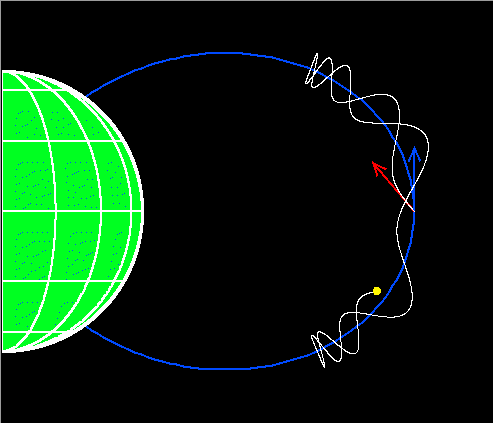
On this page I offer some definitions of jargon from the field of space physics, along with illustrations and/or links to more information.
Dst or DstThis is the "storm-time disturbance" in the Earth's magnetic field, measured by a network of magnetometer stations near the equator. During geomagnetic storms, there is a large increase in the population of moderate-energy (around 100 keV) ions in the magnetosphere, whose combined motions add up to a "ring current" around the Earth. The magnetic field produced by this current points in the opposite direction from the Earth's internal field, and so its effect is to reduce the strength of the magnetic field measured at these magnetometers. Dst is measured in nanotesla (nT), where one Gauss is 100,000 nT; a really strong ring current can produce a field depression measured at -300 nT or even more. A webpage from the World Data Center in the UK gives references and more details.
This is the flux of radio noise coming from the sun at a wavelength of 10.7 cm, measured at an observatory in Canada. It is commonly used as a proxy for solar ultraviolet output, since both ultraviolet light and radio noise come from active regions on the Sun but only the radio waves make it to the surface of Earth for convenient measurement. Thus, for example, F10.7 is used as a parameter of the NRLMSISE-00 atmospheric model, since solar ultraviolet heats up and expands the upper reaches of the atmosphere. A webpage from the World Data Center in the UK gives references and more details.
This is the "planetary K index," an average of the "K indices" observed at each of thirteen high-latitude magnetometer stations. Each station's K index is a measure of the magnitude of irregular variations in the magnetic field observed there over a three-hour period, and ranked as 0, 0+, 1-, 1, 1+, ... , 8+, 9-, or 9 from quiet to very disturbed. A webpage from the World Data Center in the UK gives references and more details.

A charged particle in a uniform magnetic field will circle around the field direction, as seen from a viewpoint looking down the field lines; it is free to travel in the direction along the field lines, so its combined motion will be a spiral like a spring coiled around a cylinder. Because the Earth's magnetic field is not uniform, the motions of charged particles are more complex, but generally they be broken down into three components. The figure above shows the motion of a charged particle near the Earth; the blue curve is a line of the magnetic field, represented as a simple dipole (like a bar magnet). Locally, the particle gyrates around and travels up or down the field line, just as in a uniform field; this is the first component of its motion. The angle between the particle's velocity vector (red arrow in the figure) and the local magnetic field direction (blue arrow) at any given point along the field line is called the pitch angle, which at the point in the figure from which the red and blue arrows are drawn is 40 degrees. Because the Earth's magnetic field is not uniform, however, it can be seen that as the particle travels farther from the equatorial plane (toward higher latitudes), and therefore closer to Earth where the magnetic field is stronger, the spiral pattern of its motion tightens up; that is, the pitch angle increases. When the particle reaches a latitude called its mirror latitude (or, equivalently, the altitude identified as its mirror altitude), the pitch angle hits 90 degrees and the particle is traveling only around the field line, not along it any further; the particle then turns around and heads toward the mirror latitude in the other hemisphere. This is the second component of charged-particle motion, a bouncing between the hemispheres.
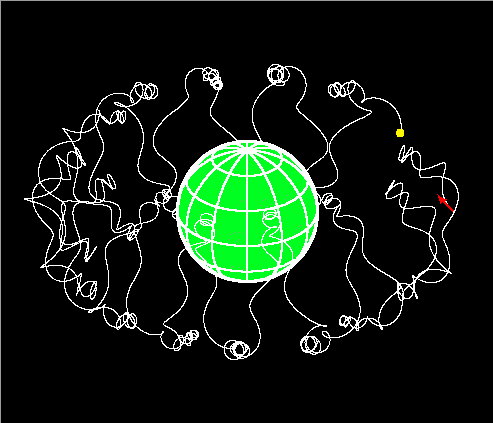
The third component is illustrated here: as the particle gyrates around the field lines and bounces up and down between hemispheres along them, it also drifts around the Earth (positively charged ions to the west, negatively charged electrons to the east). The field lines are not shown in this figure, to make it a bit more legible, but it can be seen that the shapes of the field lines being followed by the particle at each longitude are the same; that is, they all are the same size. The magnetic field lines of a dipole are all the same shape, as illustrated in the first figure, but scale up or down to varying sizes. The scale factor of a given field line in Earth's field is identified by the distance, in Earth radii, from the center of the Earth to where the field line crosses the equator. This is denoted by L; in the first figure, L is about 3. In the second figure, you can see that the field line being followed by the particle at each longitude also has L = 3; thus the set of field lines about which the particle gyrates as it bounces and drifts make up a toroidal shell of all field lines with the same value of L, which we not surprisingly refer to as the L shell at which that particle resides, along with all others that are at different phases of their gyration, bounce, or drift motions at any given time but that move on the same set of field lines.
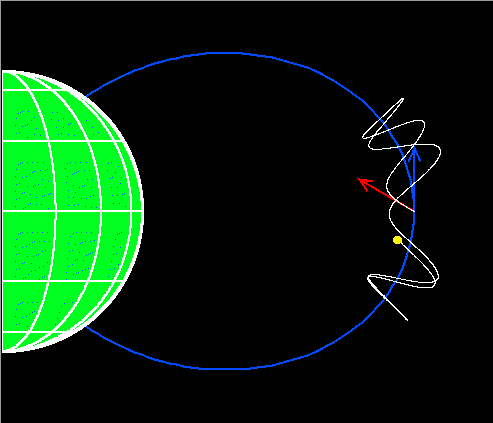
If the pitch angle of the particle is more steeply inclined to the magnetic field at the equator, i.e., if its pitch angle is numerically larger, it will not travel as far up the field line before mirroring and heading back toward the equator. This figure shows the motion of a particle with a pitch angle of 60 degrees at the equator, and you can see that it does not travel to as high a latitude as the particle in the previous plot. Thus, while every particle trapped in the magnetic field will be observable at the equator, as the point of observation moves to higher latitudes along a given field line (and therefore to lower altitudes) particles with greater equatorial pitch angles than a certain limit will cease to be observable since they won't make it up to the latitude of the sensor. This is why we like to have observations in the equatorial plane: the field lines where most of the trapped particles reside are only crossed at very high latitudes by a low-altitude satellite like SAMPEX, which means that we simply can't observe most of the particles that are present along the field line.
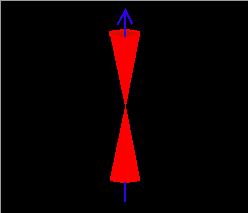
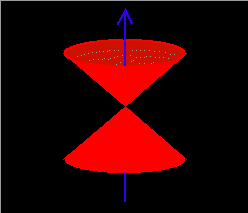
A low-altitude satellite has other advantages, of course, one of them being that it orbits the Earth fifteen times a day and therefore resamples a given L shell fairly frequently. Another advantage, for observations of certain physical processes, has to do with the way particles move as they approach low altitudes. Note that, if a particle has a pitch angle at the equator that is too small (close to zero degrees) or too large (close to 180 degrees), it will travel so far along the field line that it will hit the Earth before it has a chance to mirror and head back toward the equator. Thus there is a limiting pitch angle such that all particles that travel more closely along the field line at the equator than that limit will hit the Earth; the velocity vectors of these particles define an equatorial loss cone, as suggested by the red two-ended cone of direction vectors in the figure to the left immediately above. Note further that, as the point of observation travels down the field line from the equator to higher latitudes and lower altitudes, the set of local pitch angles (that is, the angles between the local magnetic field and the local velocity vectors) that will run into the Earth before completing a full cycle of bounce motion widens, so that at the 600 km altitude of SAMPEX the loss cone can look more like the figure to the right above (or even wider). Thus, to study the physical processes that dump particles from the radiation belts into the atmosphere (whether considered as an energy input to the atmosphere, or as a loss process that helps determine the content of the radiation belts), a satellite radiation sensor can more easily ignore trapped particles (those that will continue bouncing) and measure only particles with velocity vectors in the loss cone if it can observe them at low altitudes, where it doesn't need as fine a resolution of particle arrival directions to decide whether a given particle is trapped or precipitating into the atmosphere.
There are other "loss cones" whose existence depends on the fact that Earth's magnetic field is in fact not the simple centered dipole sketched here. One of these, the "drift loss cone," has been particularly useful for analyzing transient injections of particles; I discuss it on another webpage, from which I actually cribbed the figures on this one.
 Back
to top of Data Pages
Back
to top of Data Pagesnew 24 November 2004